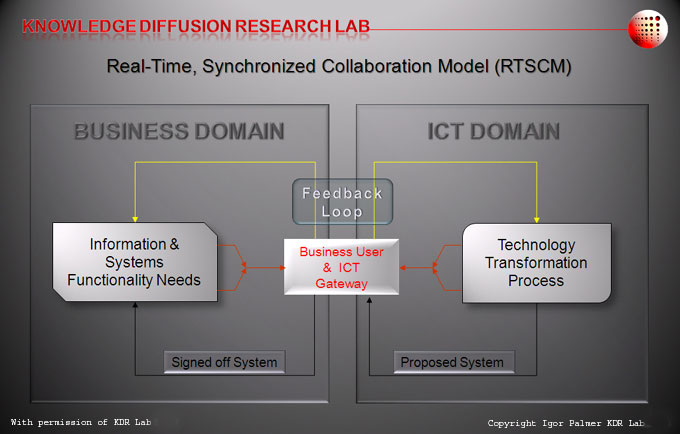Building on the the RTSC Model - originally developed by Knowledge Diffusion Research Lab - we help organizations to synthesize their core domains - Business and Information Communication Technology (ICT). The conventional channel management and relationship management business/technology inter connectivity models are overly prescriptive, thus do not function well within fast paced, competitive, and unpredictable environments.
The RTSC Model presents a fundamentally different thinking paradigm. Instead of connecting the separate domains through traditional communication channels or hierarchical management chain, Business and ICT domains are synthesized within the BU & ICT Gateway. One of the distinct attributes of the RTSCM is that the gateway incorporates closely coupled expert knowledge from both: business and ICT domains; thus any input from either of the domains is dealt by the subject matter experts within the respective domains. The other distinct feature of RTSCM is that any accumulated or new knowledge, expertise & experience are encapsulated, and retained within the centralized gateway, thus providing single point of access to accumulated knowledge and expertise to all who need it. In essence the BU&ICT gateway acts as a central repository of expert knowledge.

After a slow start and some early skepticism in recognizing KM as a potent management practice, KM has gained significant prominence within the corporate and the government space. Astute managers and sharp executives recognize that it is knowledge, which differentiates an organization from its competitors. However, there are still widely differing views about what constitutes Knowledge Management. Some view KM as a system of aggregation, centralization, organization and codification of information in terms of contextual meaning. Others view KM as a process of elicitation of expert and tacit knowledge from knowledge workers.
Whilst the first view is based on a more traditional approach to managing knowledge, there is now a greater tendency to see expert knowledge in terms of a valuable organizational asset, which resides in the knowledge workers' heads and is not as readily harnessable as the codified knowledge.
This presents a dilemma: on one hand organizations need to harness the power of their people's knowledge, and on the other hand people either cannot articulate or are not willing to share their knowledge. Moreover, knowledge bearers understand that their tacit knowledge is also their most potent asset; thus they tend to be very protective of their knowledge. The reality is that it is impossible to capture expert's tacit knowledge with conventional management practices, such as mandating knowledge sharing or through imposition of traditional business rules, or other management "tricks".
According to he Gartner Group's survey of 1,400 corporate leaders, Business Intelligence (BI) & KM projects were the number one technology priority for most of them. They considered BI and KM to be the two most significant strategic initiatives for innovation and effectiveness. Whilst powerful technologies play a significant role in KM & BI systems' overall composition, the reality is that unless the input and the output of such systems are well received by the knowledge community, knowledge workers resist sharing their most valuable asset. Nonetheless; there are ways and proven management practices which, if properly applied, can persuade people to share willingly their expert and tacit knowledge.
We continually study the epistemology, and the evolution of knowledge management practices and we ready to share our know-how and experience in building successful KM systems.



